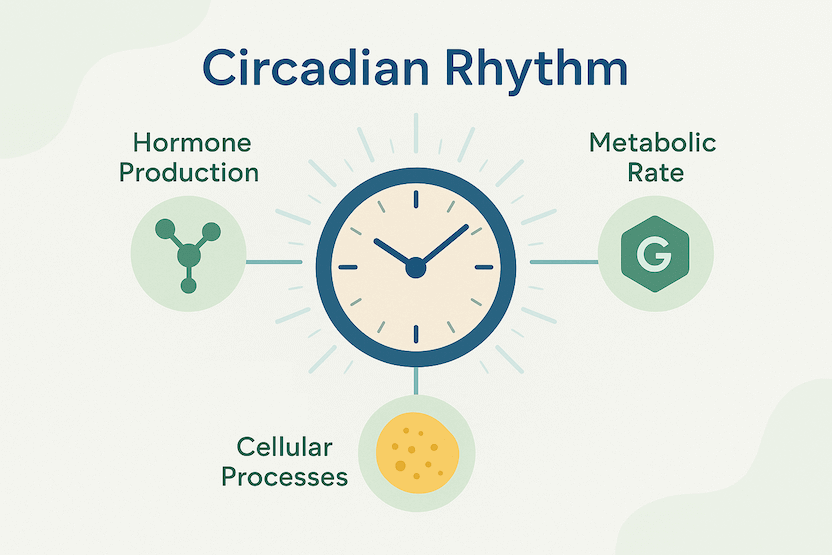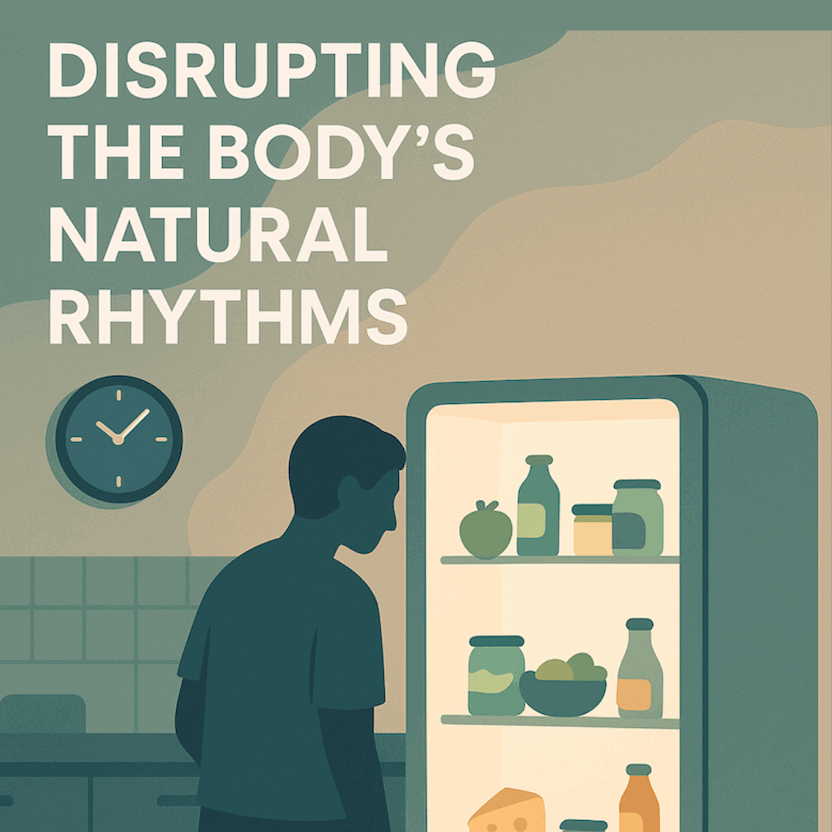Last update: July 6, 2025
8 minute read
Chrononutrition: How Can Aligning Meal Timing with Your Circadian Rhythm Improve Your Health and Metabolism?
Learn how aligning meal timing with your circadian rhythm (chrononutrition) can improve your metabolism, increase energy, and improve overall health.

By Derick Rodriguez, Associate Editor
Edited by Dr. Dimitar Marinov, MD, RDN, PhD

Did you know that eating the same meal at different times can dramatically change how your body uses nutrients? Sounds strange, but new evidence in the field of chrononutrition suggests it's true—when you eat can also influence health outcomes.
From improving metabolism and insulin sensitivity to even affecting our sleep and energy levels, matching meals to your circadian rhythm may benefit metabolic health and well-being.
And while supplements like certain probiotics may support gut health and immune function in some individuals, aligning our eating schedules with our internal biological clock offers a powerful lever to boost health.
Key takeaways
- Chrononutrition means matching your meals to your natural circadian rhythms
- Eating earlier in the day aligns with peak insulin sensitivity, improving metabolism and helping your body use nutrients more efficiently
- Consistent meal timing can support energy levels, improve weight management, and help optimize sleep quality
What is chrononutrition?
Chrononutrition is the focused study of the interplay between food intake, metabolism, and your body's internal clock—the circadian system.
This internal clock guides many biological activities, including hormone production, metabolic rate, and even how our cells process glucose and fat.

Still scratching your head about "circadian system"? In plain English, it's our body’s master schedule, governing daily cycles like sleep, hormone release, and digestion, mainly in response to light and darkness.
Matching meal times with your circadian rhythm—the natural, roughly 24-hour cycle that governs physiological functions—may improve everything from weight management to blood sugar control.
For example, studies have shown that aligning eating patterns with your natural circadian cycle has been associated with improved metabolic markers and may lower long-term disease risk.
Irregular eating patterns, however, have been linked to a higher risk of metabolic problems like obesity, insulin resistance, and type 2 diabetes.
Reasons for this may be:
- People who eat irregularly also experience hunger irregularly, leading to unexpected hunger strikes and cravings, getting caught by their appetite off-guard and looking for quick, energy-dense options. This leads to overeating, obesity, and associated health issues.
- People who eat late at night, typically when they have more time to relax, often do not feel any hunger the next morning. The lack of food and especially protein in the first half of the day leads to the accumulation of hunger in the evening, leading to another late-night overeating and turning it into a vicious cycle.

How meal timing influences health
Chronobiology—the science of biological rhythms—has shown how eating at certain times can fit with spikes and dips in hormonal and metabolic activity.
For most people, key metabolic processes like insulin sensitivity and glucose metabolism peak in the morning and early afternoon, making these the best times for bigger meals.
You might be thinking: What exactly are “insulin sensitivity” and “glucose metabolism”? Insulin sensitivity describes how well your cells respond to insulin, allowing them to absorb sugar from the blood.
More sensitivity means your body processes food more easily and keeps blood sugar stable. A well-known saying in this field—"Eat breakfast like a king, lunch like a prince, and dinner like a pauper"—shows this evidence, encouraging most caloric intake earlier in the day.

In fact, a meta-analysis of 9 recent RCTs (2023) has found that individuals who eat a larger portion of their daily calories earlier rather than later have better weight loss results and healthier heart and metabolic profiles.
It suggested that shifting more calorie consumption to earlier hours was associated with greater short-term weight loss and improved cholesterol profiles.
Here’s a summary table highlighting findings from recent studies:
Study Type | Participants | Key Findings |
|---|---|---|
Animal Studies | Mice | More weight gain when fed during usual sleep times vs. Active times |
Observational Studies | Adults | Late lunch linked to less weight loss compared to eating lunch earlier |
Meta-Analyses | Multiple RCTs (≈400–500 participants) | Greater weight loss and lower LDL cholesterol reported with earlier energy intake |
Clinical Trials | Adults | Higher blood glucose levels after nighttime eating |
Systematic Reviews | 8 trials, 116 human subjects | Higher postprandial glycemia after nighttime carbohydrate intake |
Human eTRF Studies | Adults | Improved insulin sensitivity, reduced oxidative stress with meals confined to early day hours |
Reading this, you may wonder what “eTRF” means. That stands for “early Time-Restricted Feeding,” where eating is limited to earlier day hours rather than spread through the night.

Get your personalized vitamin recommendations in less than 3 minutes.
Get your personalized vitamin recommendations in less than 3 minutes.

Aligning meals with your clock
The circadian system is controlled by environmental cues like light exposure, but also by daily habits—namely, when you eat.
Disruptions to regular meal timing, common among shift workers, travelers, or those with erratic schedules, can lead to unexpected hunger strikes, consuming easily accessible junk food, overeating and metabolic problems.
This risk increases when meals are eaten late in the evening or at night. That’s where meal timing cues come in.
VitaRx Tip
Your circadian rhythm is not only set by sunlight and sleep, but is also directly influenced by the timing of your meals. Aligning your main meals with daylight hours (ideally between 8 a.m. and 6 p.m.) helps strengthen a healthy metabolic rhythm.
But wait—what makes shift work so risky? The irregular hours disrupt both sleep and mealtimes, putting the body’s metabolic processes out of sync, which can lead to increased obesity and diabetes risk.
Still curious how food acts as a circadian cue? Whenever you eat, you send signals to your body that can shift the timing of clocks in organs like your liver and pancreas, affecting how food is processed.
— Dr. Dimitar Marinov, MD, RDN, PhDRegardless of meal-timing, overall energy balance is the key. Irregular meal times disrupt normal hunger cues, causing sudden cravings and looking for “fast” solutions - thus promoting overeating on fast foods and weight gain. Eating late often suppresses morning appetite, so people skip breakfast, build up hunger throughout the day, especially due to lack of protein and then overeat again at night, when people have more time to relax, perpetuating a cycle of late-night bingeing and calorie excess.
Practical strategies
Here are research-backed ways we can support a healthy circadian rhythm through nutrition:
- Front-load calories: Eat a healthy breakfast soon after waking—this starts metabolism when insulin sensitivity is highest.
- Big, timely lunch: Enjoy lunch earlier in the afternoon to get the most from high metabolic efficiency.
- Early dinner: Keep dinner light and aim to finish eating by early evening (5–7 p.m.), leaving several hours before bedtime.
- No late snacks: Avoid late-night snacking to prevent misalignment and support stable blood sugar levels overnight.
- Consistency counts: Stick to regular daily routines in both meal frequency and scheduling—consistent timing makes circadian signals stronger.
Now, what if your schedule sometimes gets off track? An occasional late meal isn’t disastrous, but repeated misalignment can blunt metabolic benefits and make healthy weight harder to maintain.
Key Recommendation | Description |
|---|---|
Healthy Breakfast | Eat in the morning, shortly after waking |
Early Dinner | Complete your last meal by early evening |
Avoid Late Eating | Stay away from food intake late at night |
Regular Meal Timing | Keep a consistent eating schedule throughout weeks |
Time-restricted feeding and fasting approaches
Two popular dietary strategies based on chrononutrition are time-restricted feeding (TRF) and circadian rhythm fasting. Both confine eating to a set window of time each day.
This approach may offer benefits for weight management and metabolic health, according to several small clinical studies published in 2022–2023.
If you’re wondering how these compare to traditional calorie restriction, instead of TRF and circadian rhythm fasting, work by restricting your time window for eating, making you more likely to consume fewer calories due to the limited time you have.
- Time-Restricted Feeding (TRF): This involves eating all meals within a consistent 8–10-hour window during the day. Preliminary studies suggest that TRF—especially when confined to earlier hours—may improve insulin sensitivity, reduce oxidative stress, and lower body fat.
- Circadian Rhythm Fasting: This approach stresses eating in sync with the body’s natural hormonal changes—most calories early, little or no food after dark - basically the aforementioned TRF, with the feeding window during the day.
VitaRx Tip
aaaaaaaaaa aaaaaaaaaa aaaaaaaaaaaaaaaaaaaa aaaaaaaaaa aaaaaaaaaaaaaaaaaaaa aaaaaaaaaa aaaaaaaaaaaaaaaaaaaa aaaaaaaaaa aaaaaaaaaaaaaaaaaaaa
Certain chronotypes—like "early birds" and "night owls"—may have unique responses to meal timing. Personalizing meal schedules according to your natural sleep-wake patterns could give extra metabolic benefits.
But does that mean there’s a single eating window for everyone? Not really—factors like age, genetics, and lifestyle shape the best timing, so small personal changes may give the best results.
For more about the science of aligning food intake with your biological clock, explore this article on food timing, circadian fasting, and metabolic health.
Frequently asked questions (FAQ)
Here are some of the most frequently asked questions about chrononutrition.
Final thoughts
Mastering meal timing according to our circadian rhythms isn't just a trendy hack—it's an evidence-based strategy for boosting metabolic health, daily energy, and lowering our risk for chronic disease.
Whether we adopt early Time-Restricted Feeding or simply shift our larger meals earlier, the science of chrononutrition gives us strong reasons to rethink daily eating patterns. We invite you to test small timing shifts and notice the difference.
Sources and references
Editor

Derick Rodriguez
Derick Rodriguez focuses on editing health and wellness-related content. With over half a decade of experience in the digital realm, Derick has developed a unique skill set that bridges the gap between complex health concepts and accessible, user-friendly communication. His approach is deeply rooted in leveraging personal experiences and insights to illuminate the nuances of health and wellness topics, making them more approachable and empowering readers with knowledge and confidence.
Fact checker

Dr. Dimitar Marinov
Dr. Marinov has years of experience in scientific research and preventive and clinical medicine. His publications in peer-reviewed journals are on nutritional status, physical activity, and musculoskeletal disorders among adolescents.
At VitaRx, we're not just passionate about our work — we take immense pride in it. Our dedicated team of writers diligently follows strict editorial standards, ensuring that every piece of content we publish is accurate, current, and highly valuable. We don't just strive for quality; we aim for excellence.
Related posts
While you're at it, here are some other relevant articles you might be interested in.

Get your personalized vitamin recommendations in less than
5 minutes.
Get your personalized vitamin recommendations in less than
5 minutes.






